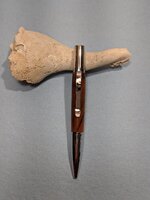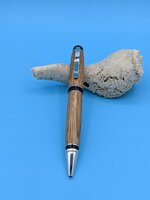Madman1978
Member
I have been storing away some wood. I have Walnut, Cedar, Maple, Red Oak, and White oak. Are any of these species any good to turn for pens?
Springfield Yes but in MassAlways tends upon the user. I personally don't like to turn Cedar... will often turn a duller color. Oak woods seem to have little pits... don't know how to explain... so I personally avoid those. I love Walnut and Maple to turn! Walnut is my favorite to work with in all genre.
(Hey... I see you're in Springfield. I'm in Enon.)
LOL.... here I thought you were in Ohio. So, much for a meet up.Springfield Yes but in Mass
They make both Fords and Chevy's so people have have a choice.I have been storing away some wood. I have Walnut, Cedar, Maple, Red Oak, and White oak. Are any of these species any good to turn for pens?


I will get some Bocote! I promise!Of the woods you mention, Maple and Walnut. . I don't like turning the others ... either because of the way they turn or the way they finish.
As PreacherJon said, Oak has little pits. . I believe there are some varieties of Cedar which turn OK but finishing is somewhat iffy.
I think I mentioned Bocote to you as my favorite wood for turning and finishing. . It seems to be harder to get than previously but it turns nicely and finishes nicely ... you can even get a very nice finish just by sanding and buffing ... not shiny gloss but I like a sort of matte finish.
Yes they are, especially with a CA finish.I have been storing away some wood. I have Walnut, Cedar, Maple, Red Oak, and White oak. Are any of these species any good to turn for pens?
I read somewhere (can't remember) about sanding with CA to fill the pores with wood dust. Tried it when I had trouble with wenge and birds' eye oak--sanded as normal to 220 or 320, then sanded again at the same grit while applying CA to the wood. Once cured, I continued finishing as normal.To get a filled pore finish, many will apply several coats of gloss finish and then sand back till a raking light shows a uniform shine or sheen. Sand back just a little and the bottom of the open pores is still shiny while the surrounding surface is dull because the surrounding surface was scratched by the sandpaper and the bottom of the open pores was not. Simply applying a number of coats to raw open pore wood may not achieve a filled pore finish, and if it does the thickness of the finish may be noticeable, that's why the first few coats are sanded back to get a level coat with a thick film buildup.
